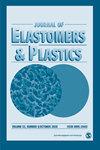动态硫化PP/EPDM共混物的流动性能、微观结构和断裂韧性
IF 1.6
4区 材料科学
Q4 MATERIALS SCIENCE, MULTIDISCIPLINARY
引用次数: 3
摘要
采用断裂方法研究了不同微观结构的聚丙烯/乙烯-丙烯-二烯三元共聚物(100/8)共混物的断裂行为。将乙烯-丙烯-二烯三元共聚物和过氧化二umyl在140℃的单螺杆挤出机中混合,在此温度下几乎没有发生交联反应。然后在双螺杆挤出机上,在160 ~ 210℃的温度范围内对乙烯-丙二烯三元共聚物和聚丙烯进行反应挤出,并在此过程中对乙烯-丙二烯三元共聚物进行交联。通过改变过氧化二氨基的浓度,得到了聚丙烯/乙丙二烯共混物(100/8)中不同交联密度的乙丙二烯三元聚合物。随着过氧化二氨基浓度的增加,共混物的熔体流动速率逐渐增大,但增大趋势减慢。采用这种处理方法,聚丙烯的降解反应明显受到抑制。从扫描电镜的结果来看,乙烯-丙烯-二烯三元共聚物的颗粒尺寸减小,颗粒尺寸分布更加均匀。用差示扫描量热法证实了聚丙烯/乙丙二烯三元共聚物接枝共聚物的存在,并验证了接枝共聚物对聚丙烯大分子接枝到乙丙二烯三元共聚物链上结晶速率的负面影响。随着过氧化二氨基浓度的增加,所制备的共混物的断裂功(we)明显增加。当过氧化二umyl的浓度为乙烯-丙烯-二烯三元共聚物含量的0.3 wt%时,动态硫化共混物的we值约为聚丙烯/乙烯-丙烯-二烯三元共聚物简单共混物或聚丙烯的165%,但比塑功(βwp)仍大于聚丙烯。本文章由计算机程序翻译,如有差异,请以英文原文为准。
Flowing Performance, Microstructures, and Fracture Toughness of Dynamically Vulcanized PP/EPDM Blends
The fracture behavior of polypropylene/ethylene—propylene— diene terpolymer (100/8) blends with different microstructure was investigated using the essential work of fracture approach. Ethylene—propylene—diene terpolymer and dicumyl peroxide were mixed in a single-screw extruder at 140°C, and the crosslinking reaction had hardly taken place at this temperature. Then the reactive extrusion of ethylene—propylene—diene terpolymer and polypropylene was performed on a twin-screw extruder at a temperature range of 160—210°C and ethylene—propylene—diene terpolymer was crosslinked in this process. Various crosslinking density of ethylene—propylene—diene terpolymer in polypropylene/ethylene—propylene—diene terpolymer (100/8) blends was obtained by varying the concentration of dicumyl peroxide. With increasing dicumyl peroxide concentration, melt flow rate of the blends gradually increased but the increasing trend was slowed up. The degradation reaction of polypropylene was markedly restrained by adopting such a processing method. From the result of scanning electron microscopy, the size of ethylene—propylene—diene terpolymer particles was reduced and a more uniform particle size distribution was obtained. The existence of polypropylene/ ethylene—propylene—diene terpolymer graft copolymer was demonstrated by differential scanning calorimetry and the negative effect of the graft copolymer on the crystalline rate of polypropylene macromolecules which were grafted onto ethylene—propylene—diene terpolymer chains was validated. The specific essential work of fracture (we) increased markedly with increasing dicumyl peroxide concentration for the blends prepared. When the concentration of dicumyl peroxide was 0.3 wt% of ethylene—propylene—diene terpolymer content, the value of we of the dynamic vulcanized blends was about 165% as that of polypropylene/ethylene—propylene—diene terpolymer simple blends or polypropylene, while the specific plastic work (βwp) was still larger than that of polypropylene.
求助全文
通过发布文献求助,成功后即可免费获取论文全文。
去求助
来源期刊

Journal of Elastomers and Plastics
工程技术-材料科学:综合
CiteScore
3.30
自引率
5.90%
发文量
41
审稿时长
6 months
期刊介绍:
The Journal of Elastomers and Plastics is a high quality peer-reviewed journal which publishes original research on the development and marketing of elastomers and plastics and the area in between where the characteristics of both extremes are apparent. The journal covers: advances in chemistry, processing, properties and applications; new information on thermoplastic elastomers, reinforced elastomers, natural rubbers, blends and alloys, and fillers and additives.
 求助内容:
求助内容: 应助结果提醒方式:
应助结果提醒方式:


